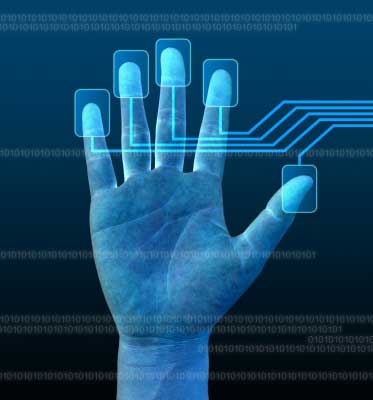
Photo by [twobee] FreeDigitalPhotos.net
This all started back in July of 1892 by a man in La Plata, Argentina, he was a member of the police force there. We’ll refer to him as Inspector Alvarez for the sake of this post.
Alvarez was sent to Necochea in order to aid in the investigation of a brutal murder of two children who had been battered to death while they slept. They lived there with their 26 year old mother Francisca Rojas and she was considered the likely suspect for the crime. The only problem was, they couldn’t force a confession from her and they really had no other supporting evidence to her committing the crime.
A Fingerprint in Blood
Upon arriving at the scene of the crime, Alvarez began his search of the shack they lived in. While digging for clues he stumbled upon a bloody fingerprint on the door. It appeared to be a print of someone’s thumb.
So Alvarez took a saw and removed the portion of the door that contained the thumbprint and carried it down to the police station for further examination. After which he sent for Francisca and had her fingerprinted to make a comparison.
Once Francisca learned that the fingerprint they took from her matched the one recovered from the door, she began singing like a bird. For those of you that don’t understand that, basically she began confessing to the crime.
Of course having her confession, there wasn’t much left to the case, it was closed and she was convicted of the horrible murders. Alvarez then became the first detective in history to ever solve a murder case by using a fingerprint.
Although this was a crude method, it worked beautifully in gaining a conviction in court.
Where Did Alvarez Learn of Fingerprints
So if this technique had never been used before, you’re probably wondering, how did Alvarez know to use the fingerprint in his investigation.
He had studied the work of a man named Juan Vucetich, a colleague of his from the bureau of statistics for the La Plata police. Vucetich’s work of using this method to analyze and classify fingerprints was something Alvarez had been following but never had the opportunity to put to work until the Necochea murders.
Vucetich’s method made it both easy to file and retrieve fingerprints and up until Alvarez’s case, his work had pretty much been ignored by law enforcement. But of course since the successful conviction of Francisca, Argentina police adopted fingerprinting as it’s main method for identifying criminals, in fact, they were the very first country to adopt this method of identification.
When Did Fingerprints Really Begin
Even though fingerprinting wasn’t fully adopted within a law enforcement agency until the late 1800s to early 1900s by Argentina, it had been discovered much earlier by a man named William Herschel in 1858. Herschel was a British civil servant who worked in India.
The way it all started was in the signing of a contract by someone that couldn’t read or write. Herschel had a local builder in India sign a contract with a palm print of his entire hand, because the man didn’t know how to sign his own name.
After receiving the palm print, Herschel noticed the uniqueness of the lines in the print. Being fascinated with this, he began collecting fingerprints of everyone he came into contact with. This allowed him to discover that every fingerprint was unique and after many years of collecting them, he also discovered that the prints remained the same throughout a person’s lifetime.
Using the work of Dr. Henry Faulds in 1880, Herschel later discovered that a fingerprint actually didn’t need ink to show up. Faulds’ work stated that the sweat and oils on the hands and fingertips was all you needed for a fingerprint to make an impression on a flat surface.
The Final Steps in Identification
It wasn’t until 1896 that a man named Edward Henry developed a classification system for identification of fingerprints. Henry divided fingerprint patterns up into five different sections. They were: Plain Arches, Tented Arches, Ulnar Loops, Radial Loops, and Whorls.
These different types of fingerprints adopted a code system of A, T, U, R, and W. Then he took it a step further by counting the amount of lines that were in a print. These were used to create a map of the triangle positions that formed where the lines were divided.
His formula for identification not only made the system easy for someone else to learn, but also made the filing and retrieval process quite rapid. In mere minutes, any fingerprint could be located.
Henry’s system became so successful that during the next few years, police all over Europe and North America adopted it and began using fingerprinting in all criminal cases. But the United States pulled up the rear by adopting fingerprinting in the 1920’s. This was after J. Edgar Hoover took over the FBI.
Today’s FBI database contains over 140 million sets of fingerprints and the number grows exponentially every year. But let’s keep in mind, fingerprints are no longer used for the sole purpose of solving crimes. There are also a number of fingerprints on file that belong to government employees, and servicemen and women who all get routinely fingerprinted.
To this day, Henry’s method, known as the Galton-Henry method is still used to identify, file and retrieve man’s unique identification, and no one print is the same.
Any other reasons a person may need to be fingerprinted? Share your views on fingerprints and if you think it’s an invasion of your privacy to have them taken, use the comments below…



Cool information right there! I had total fun learning and reading more of it. I asked the same thing too. I thought it what so brilliant to use this kind of technique in finding what is true. After all, finger prints are very unique.
Thank you for the comment Emilia. I too find it fascinating how unique the human body is. It’s just amazing that out of 6 billion or more people on Earth, no two people have the same fingerprints. It makes for positive identification with absolute certainty. 🙂
A very informative article. learned alot about the fingerprints and how can it be used to track the criminals.
Great! I’m really glad you found the post educational, there’s so many neat things to be learned from our history.
Thanks a bunch for stopping by.
nice post about the first use of the fingerprints for snatching the culprits.
Another informative article from odd random thoughts indeed!
Good Information about the finger prints history.Great research by the Alvarez and mainly by the Robert who told all these.
Yep, Inspector Alvarez was a huge part of revolutionizing fingerprinting. It is crucial in today’s investigative techniques, I can’t imagine where law enforcement would be today without fingerprints.